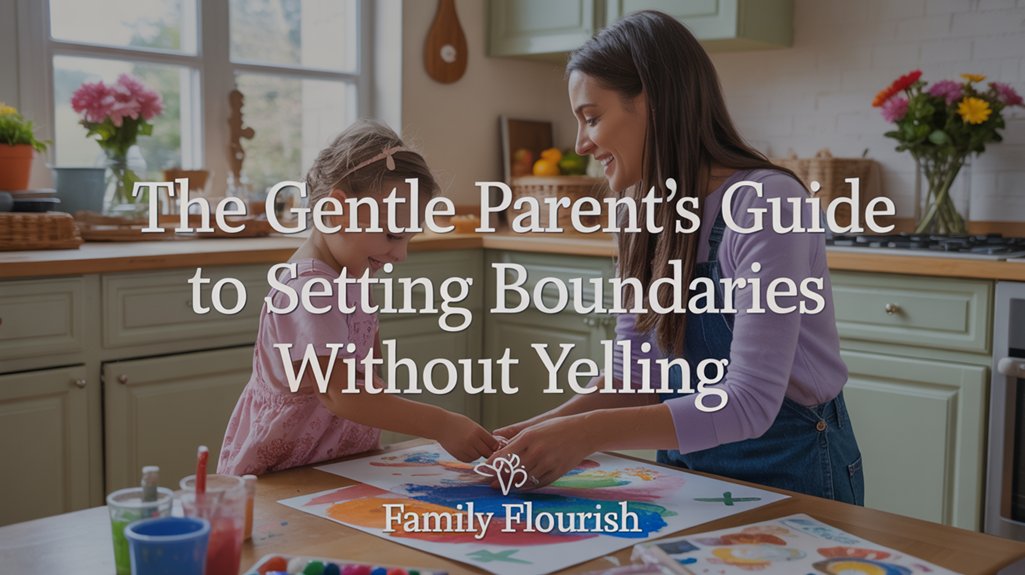You can set firm boundaries without yelling by maintaining a calm tone that allows your child's brain to actually process the limit. When you raise your voice, stress hormones block their reasoning ability, making boundary-setting ineffective. Instead, use eye-level communication, validate their emotions while holding firm to rules, and offer choices within established limits. Your composed presence activates their prefrontal cortex for better learning. Understanding the neuroscience behind this approach, along with age-specific techniques and strategies for managing your own triggers, will change how your family navigates discipline.
Key Takeaways
- Gentle parenting enforces clear, consistent boundaries with empathy while holding children accountable, unlike permissive parenting which avoids limits.
- A calm tone activates children's mirror neurons and prefrontal cortex, promoting cooperation and emotional regulation better than harsh voices.
- Age-appropriate boundaries reduce power struggles: toddlers need simple rules, while teens require limits that balance safety with growing autonomy.
- Use natural consequences, positive reinforcement, and steady presence at eye level rather than punishment or raised voices for enforcement.
- Manage your triggers by pausing to breathe, naming emotions internally, and modeling self-regulation before responding to boundary testing.
Understanding the Difference Between Gentle Parenting and Permissive Parenting
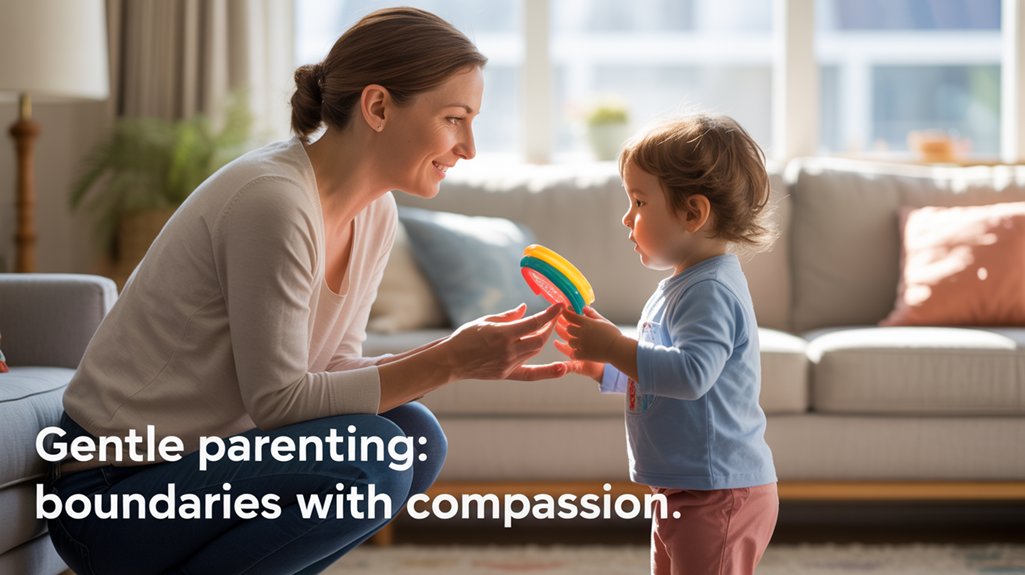
While both gentle parenting and permissive parenting may appear similar on the surface, they're fundamentally different in their approach to child-rearing.
Gentle parenting maintains firm boundaries while respecting your child's emotions and autonomy. You set clear expectations and enforce consistent limits, but you do so with empathy and understanding. Research shows this approach develops self-regulation and emotional intelligence in children.
Permissive parenting, conversely, avoids setting boundaries altogether. You might fear conflict or believe that saying “no” damages your relationship. This creates confusion for children who need structure to feel secure.
The key distinction lies in accountability. With gentle parenting, you hold your child responsible for their behavior while teaching appropriate alternatives. You're not their friend—you're their guide.
Permissive parenting lacks this essential framework, leaving children without the skills they need to navigate social expectations.
Understanding this difference equips you to parent confidently, knowing that boundaries actually strengthen your connection. This approach aligns with current thinking from pediatric experts who emphasize the importance of balanced structure and emotional responsiveness in child development.
Why Children Actually Need and Crave Clear Boundaries
Though it may seem counterintuitive, children feel most secure when they know exactly where the limits are. Research consistently shows that boundary needs are fundamental to healthy development. When you establish clear expectations, you're providing the framework children require to navigate their world confidently.
Children's brains aren't fully developed, particularly the prefrontal cortex responsible for impulse control and decision-making. They're literally craving structure from you to help regulate their emotions and behavior.
Children's developing brains need external structure to compensate for their immature prefrontal cortex and learn emotional regulation.
Consider these developmental realities:
- Predictability reduces anxiety – Knowing what to expect helps children feel safe and understood.
- Boundaries teach self-regulation – Consistent limits become internalized guidelines for behavior.
- Clear expectations build trust – Children learn they can depend on you for guidance.
Without boundaries, children often escalate behaviors—not from defiance, but from seeking the container they need. You're not restricting them; you're providing security that enables genuine freedom to explore within safe parameters.
Just as children need structure in boundary-setting, they also require healthy development support through proper medical care and routine wellness practices that promote their overall thriving.
The Science Behind Calm Boundary-Setting: How Your Tone Affects Your Child's Brain
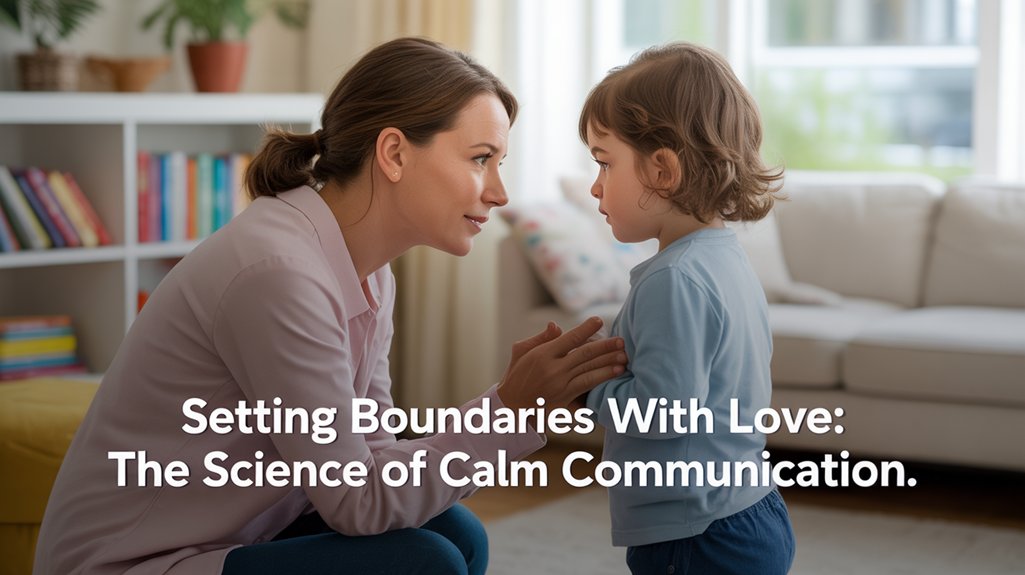
When you raise your voice or use harsh tones during boundary-setting, your child's brain releases cortisol and adrenaline, which actually impairs their ability to process what you're saying and learn from the moment.
Your calm demeanor activates your child's mirror neurons, causing their nervous system to regulate in response to yours—this neurological phenomenon explains why they're more likely to cooperate when you're composed.
The way you deliver boundaries directly impacts your child's developing prefrontal cortex, the brain region responsible for impulse control and emotional regulation, making your tone as important as the boundary itself.
Stress Hormones and Learning
As your voice rises in frustration, your child's brain floods with cortisol—a stress hormone that actively blocks the prefrontal cortex, the very region responsible for reasoning, impulse control, and learning.
This stress response makes it neurologically impossible for your child to process your message effectively.
When you maintain a calm tone, you promote emotional regulation and keep your child's brain receptive to learning:
- Lower cortisol levels preserve access to higher-order thinking skills needed for understanding consequences
- Activated prefrontal cortex enables your child to connect actions with outcomes and modify behavior
- Reduced amygdala reactivity allows rational processing rather than triggering fight-or-flight responses
Your measured voice literally changes your child's brain chemistry, altering discipline moments into genuine learning opportunities rather than survival reactions.
Mirror Neurons in Action
Your child's brain contains specialized neurons that automatically mirror the emotional states they observe in you—a phenomenon neuroscientists call the mirror neuron system.
When you remain calm during boundary-setting, these neurons fire in your child's brain, creating emotional resonance that promotes self-regulation. Research demonstrates that mirror neuron empathy functions bidirectionally: your composure literally shapes their neural responses.
This neurological mechanism explains why yelling often escalates rather than resolves behavioral issues. When you're agitated, your child's mirror neurons activate corresponding stress responses, flooding their system with cortisol and diminishing their capacity for rational thought.
Conversely, maintaining a steady tone activates their prefrontal cortex, enabling them to process limits effectively.
Your emotional regulation becomes their template for developing self-control—making your calm demeanor the most powerful boundary-setting tool available.
Prefrontal Cortex Development Impact
The prefrontal cortex—your child's executive control center—doesn't fully mature until their mid-twenties, with the most dramatic development occurring between ages three and seven.
During this critical window, your calm approach directly supports healthy neural pathway formation for emotional regulation.
When you maintain composure while setting boundaries, you're actively teaching your child's developing prefrontal cortex how to:
- Process emotions without triggering fight-or-flight responses that bypass rational thought
- Build neural connections between the emotional limbic system and reasoning centers for better self-control
- Strengthen stress-response patterns that favor thoughtful decision-making over reactive behavior
Your regulated presence becomes the scaffold their developing brain needs.
Each calm interaction strengthens their capacity for impulse control, emotional awareness, and independent regulation—skills that serve them throughout life.
Establishing Age-Appropriate Limits That Stick
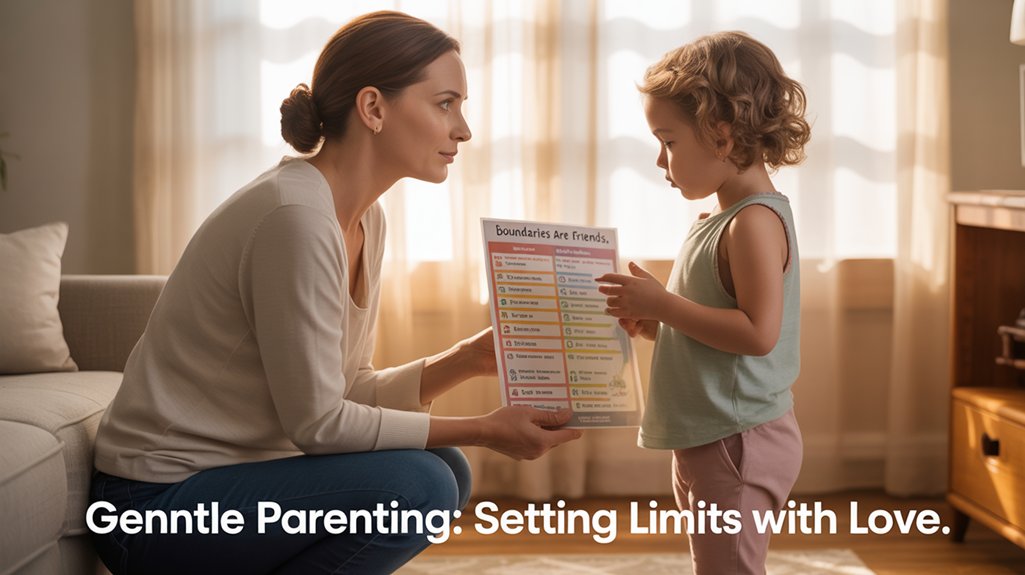
You'll need to calibrate expectations according to age milestones.
Toddlers (18-36 months) require simple, consistent limits: “We touch gently” or “Food stays at the table.” Their developing impulse control means you'll repeat these boundaries frequently.
Simple, repetitive boundaries work best for toddlers—their impulse control is still developing, so expect to reinforce limits consistently and patiently.
Preschoolers (3-5 years) can grasp cause-and-effect reasoning. Limit examples include: “We use quiet voices inside so everyone feels comfortable” or “You can choose the red cup or the blue cup.”
School-age children (6-12 years) benefit from collaborative boundary-setting. Involve them in establishing household rules and logical consequences. This participation increases buy-in and compliance.
Adolescents need boundaries that acknowledge growing autonomy while maintaining safety. Focus on non-negotiables (curfews, substance use) while allowing negotiation on lesser issues.
Research confirms that age-appropriate limits reduce power struggles while building self-regulation skills.
Practical Techniques for Enforcing Rules Without Raising Your Voice
When boundaries meet resistance, calm enforcement becomes your most powerful tool. Your emotional regulation sets the foundation for your child's behavioral response. Research shows children mirror the emotional states they observe, making your composed demeanor essential for effective limit-setting.
Implement these evidence-based strategies:
- Use natural consequences instead of punishments – Allow logical outcomes to reinforce the boundary (e.g., toy removal after misuse rather than verbal reprimands)
- Employ positive reinforcement consistently – Acknowledge cooperation immediately with specific praise: “You handled that disappointment calmly”
- Apply the proximity principle – Move physically closer to redirect behavior through gentle touch or quiet reminders rather than shouting across rooms
When enforcement requires intervention, maintain eye contact and speak at conversational volume. Your steady presence communicates authority more effectively than increased volume.
This approach respects your child's dignity while maintaining necessary structure, encouraging cooperation rather than compliance born from fear.
What to Do When Your Child Tests Boundaries (And They Will)

Boundary testing isn't defiance—it's your child's developmentally appropriate way of learning how the world works and whether you'll stay consistent.
When your four-year-old pushes back after you've said “no more screen time” for the third time today, their brain is actually gathering critical data about safety, predictability, and trust.
Your calm, steady response in these moments teaches more about respect and self-regulation than a hundred lectures ever could.
Why Testing Is Normal
If your child pushes against every limit you set, they're doing exactly what their brain is wired to do.
Boundary exploration represents normal behavior in childhood development, not defiance or disrespect toward you.
Research confirms children test limits to:
- Learn cause and effect – They're discovering whether boundaries remain consistent and what happens when they push back.
- Develop autonomy – Testing helps them understand their power and independence within safe parameters.
- Gauge your reliability – Repeated testing confirms you'll maintain structure even when challenged.
This process isn't pleasant, but it's essential.
When you recognize testing as developmental work rather than personal opposition, you'll respond with greater patience.
Your consistency during these moments teaches children that boundaries exist for their protection, building the security they need to thrive.
Calm Response Strategies
Your child screams “No!” and throws their toy after you've calmly stated screen time is over. This moment tests everything you've learned about boundaries.
First, practice calm breathing—take three slow breaths before responding. This regulates your nervous system and models emotional regulation for your child.
Kneel to their eye level and acknowledge their feelings: “You're upset screen time is ending.”
Then, hold the boundary firmly: “The rule stays. Screen time is finished.”
Offer a choice within limits: “You can play blocks or read books.”
When they eventually comply, use positive reinforcement immediately: “Thank you for making a choice.” This strengthens future cooperation.
Remember: your calm, consistent response teaches them that boundaries aren't negotiable, but their feelings about boundaries are always valid.
Managing Your Own Triggers and Staying Calm Under Pressure
When children push against limits, parents often experience physiological arousal—elevated heart rate, muscle tension, racing thoughts—that mirrors the stress response their children display.
Recognizing these bodily signals before reaching your breaking point enables you to implement emotional regulation techniques effectively.
Self-awareness practices help you identify your unique trigger patterns. Notice which behaviors—whining, defiance, repeated limit-testing—activate your stress response most intensely.
Three evidence-based strategies for managing parental triggers:
- Pause and breathe – Take three deep diaphragmatic breaths to activate your parasympathetic nervous system, reducing cortisol levels and creating space between stimulus and response.
- Name your emotion internally – Labeling feelings (“I'm feeling frustrated”) reduces amygdala activation by 30-50%, helping you respond rather than react.
- Create physical distance briefly – Step away momentarily when safe to do so, modeling self-regulation for your child while preventing escalation.
Your calm presence teaches children emotional management more effectively than any words.
Consistency Is Key: Creating a Family Boundary Framework That Works
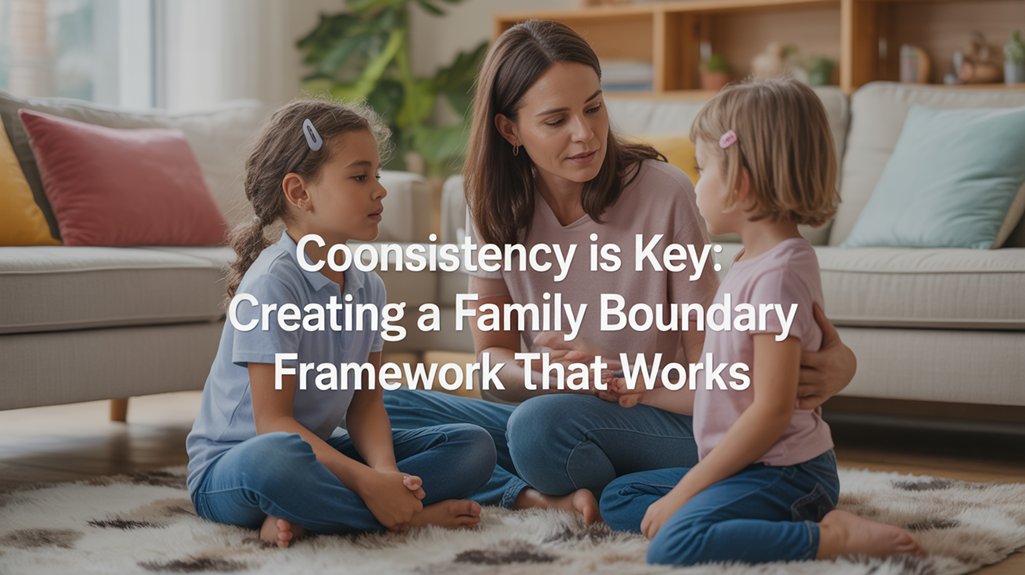
Managing your emotional responses creates the foundation for effective boundary-setting, but even the calmest parent struggles when household rules change daily or vary by circumstance. Consistency alters scattered reactions into a coherent framework aligned with your family values and parenting goals.
Begin by identifying boundary types that reflect what matters most to your household:
| Boundary Type | Family Values Connection | Implementation Strategy |
|---|---|---|
| Safety boundaries | Physical well-being | Non-negotiable, immediate enforcement |
| Respect boundaries | Mutual dignity | Model desired communication styles |
| Responsibility boundaries | Independence, accountability | Age-appropriate expectations |
| Emotional boundaries | Self-awareness | Validate feelings, maintain limits |
| Social boundaries | Community connection | Discuss rationale openly |
Document your core boundaries where everyone can reference them. When you're tempted to relax a rule, ask: “Does this serve my child's development?” Predictability doesn't mean rigidity—adjust boundaries as children mature while maintaining your foundational principles. This consistency provides the security children need to thrive.
Frequently Asked Questions
How Do I Set Boundaries When Co-Parenting With Someone Who Yells?
You'll need clear communication strategies that protect your child while modeling healthy boundaries.
Document your co-parenting tips in writing—use email or parenting apps to minimize verbal conflict.
When your co-parent yells, calmly end the interaction: “I'll continue this conversation when we're both calm.”
Focus on what you can control: your responses, your home's emotional safety, and teaching your child that yelling isn't how respectful people communicate.
Consistency matters more than perfection.
What if My Child Has Special Needs or Developmental Delays?
Like tailoring a suit to fit perfectly, you'll need individualized approaches that honor your child's unique developmental profile.
Adapt your expectations and timelines based on their capacities, not arbitrary milestones. Communication strategies should match their processing speed—using visual supports, simplified language, or sensory cues as needed.
Research shows consistent, developmentally appropriate boundaries actually reduce anxiety in children with special needs.
You're building safety through understanding, not demanding neurotypical responses.
Can Grandparents Undermine My Gentle Parenting Boundaries During Visits?
Yes, grandparents can undermine your boundaries, but you'll prevent this through proactive communication.
Schedule boundary discussions before visits, clearly explaining your approach and specific expectations. Share your “why” behind gentle parenting to build understanding.
When grandparents resist, acknowledge their experience while firmly maintaining your standards. You're not rejecting their love—you're protecting your child's emotional development.
How Do I Handle Boundary-Setting in Public Places or Restaurants?
You'll maintain boundaries in public by preparing your child beforehand with clear expectations and involving them in restaurant strategies like menu choices.
When correction's needed, move to a quieter space rather than disciplining where others watch. Public etiquette doesn't require perfection—it requires consistency.
You're modeling respectful behavior while honoring your child's developmental stage. Remember, onlookers' judgments don't define your parenting success.
Stay calm, follow through with predetermined consequences, and you'll teach valuable social skills without shaming.
What if I've Already Yelled for Years—Is It Too Late?
It's never too late. You can repair, you can reconnect, you can rebuild trust—starting today.
While yelling impact affects children's stress responses, research shows kids are remarkably resilient when parents change.
Your parenting reset begins with acknowledging past patterns, apologizing authentically, and consistently practicing new responses. Neural pathways reshape through repetition.
You'll model accountability, emotional regulation, and growth—powerful lessons that transcend previous mistakes.
Your children need your healthier presence now, not your perfect past.
Conclusion
You've now got the framework to change your entire household interaction. Remember, boundary-setting without yelling isn't about perfection—it's about progress. Research consistently shows that children thrive when they experience firm, calm guidance from emotionally regulated parents. You'll stumble, and that's expected. What matters is your commitment to responding rather than reacting. When you maintain consistency while honoring your child's developmental needs, you're building their emotional resilience for life.

